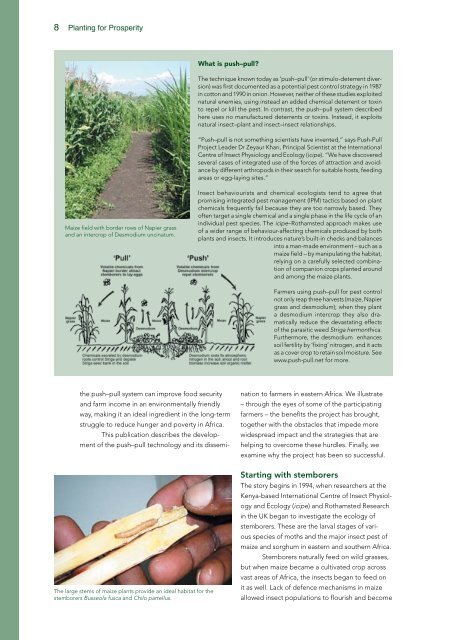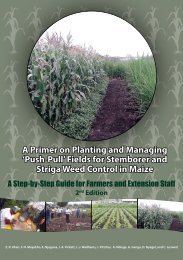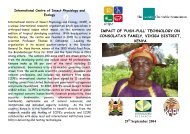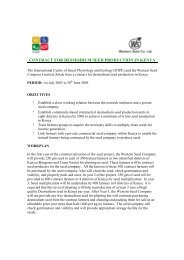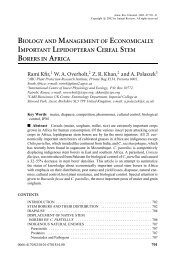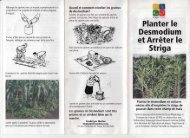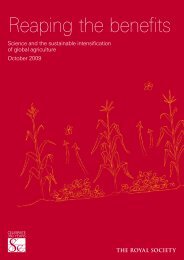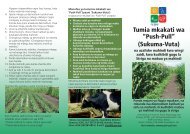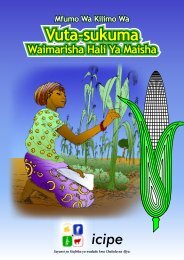a model for Africa's green revolution - Push-Pull
a model for Africa's green revolution - Push-Pull
a model for Africa's green revolution - Push-Pull
You also want an ePaper? Increase the reach of your titles
YUMPU automatically turns print PDFs into web optimized ePapers that Google loves.
8 Planting <strong>for</strong> Prosperity<br />
What is push–pull<br />
The technique known today as ‘push–pull’ (or stimulo- deterrent diversion)<br />
was first documented as a potential pest control strategy in 1987<br />
in cotton and 1990 in onion. However, neither of these studies exploited<br />
natural enemies, using instead an added chemical deterrent or toxin<br />
to repel or kill the pest. In contrast, the push–pull system described<br />
here uses no manufactured deterrents or toxins. Instead, it exploits<br />
natural insect–plant and insect–insect relationships.<br />
“<strong>Push</strong>–pull is not something scientists have invented,” says <strong>Push</strong>-<strong>Pull</strong><br />
Project Leader Dr Zeyaur Khan, Principal Scientist at the International<br />
Centre of Insect Physiology and Ecology (icipe). “We have discovered<br />
several cases of integrated use of the <strong>for</strong>ces of attraction and avoidance<br />
by different arthropods in their search <strong>for</strong> suitable hosts, feeding<br />
areas or egg-laying sites.”<br />
Maize field with border rows of Napier grass<br />
and an intercrop of Desmodium uncinatum.<br />
Insect behaviourists and chemical ecologists tend to agree that<br />
promising integrated pest management (IPM) tactics based on plant<br />
chemicals frequently fail because they are too narrowly based. They<br />
often target a single chemical and a single phase in the life cycle of an<br />
individual pest species. The icipe–Rothamsted approach makes use<br />
of a wider range of behaviour- affecting chemicals produced by both<br />
plants and insects. It introduces nature’s built-in checks and balances<br />
into a man-made environment – such as a<br />
maize field – by manipulating the habitat,<br />
relying on a carefully selected combination<br />
of companion crops planted around<br />
and among the maize plants.<br />
Farmers using push–pull <strong>for</strong> pest control<br />
not only reap three harvests (maize, Napier<br />
grass and desmodium); when they plant<br />
a desmodium intercrop they also dramatically<br />
reduce the devastating effects<br />
of the parasitic weed Striga hermonthica.<br />
Furthermore, the desmodium enhances<br />
soil fertility by ‘fixing’ nitrogen, and it acts<br />
as a cover crop to retain soil moisture. See<br />
www.push-pull.net <strong>for</strong> more.<br />
the push–pull system can improve food security<br />
and farm income in an environmentally friendly<br />
way, making it an ideal ingredient in the long-term<br />
struggle to reduce hunger and poverty in Africa.<br />
This publication describes the development<br />
of the push–pull technology and its dissemination<br />
to farmers in eastern Africa. We illustrate<br />
– through the eyes of some of the participating<br />
farmers – the benefits the project has brought,<br />
together with the obstacles that impede more<br />
widespread impact and the strategies that are<br />
helping to overcome these hurdles. Finally, we<br />
examine why the project has been so successful.<br />
The large stems of maize plants provide an ideal habitat <strong>for</strong> the<br />
stemborers Busseola fusca and Chilo partellus.<br />
Starting with stemborers<br />
The story begins in 1994, when researchers at the<br />
Kenya-based International Centre of Insect Physiology<br />
and Ecology (icipe) and Rothamsted Research<br />
in the UK began to investigate the ecology of<br />
stemborers. These are the larval stages of various<br />
species of moths and the major insect pest of<br />
maize and sorghum in eastern and southern Africa.<br />
Stemborers naturally feed on wild grasses,<br />
but when maize became a cultivated crop across<br />
vast areas of Africa, the insects began to feed on<br />
it as well. Lack of defence mechanisms in maize<br />
allowed insect populations to flourish and become


